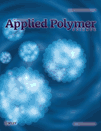Effects of surface modification of self-healing poly(melamine-urea-formaldehyde) microcapsules on the properties of unsaturated polyester composites
Abstract
Poly(melamine-urea-formaldehyde) (MUF) microcapsules used as self-healing component of composites were prepared by in situ polymerization. The surface of MUF microcapsules was modified by 3-aminopropyltriethoxy silane-coupling agent (KH550). The interfacial interactions between MUF microcapsules and KH550 were studied by Fourier transform infrared spectra (FTIR). FTIR results show that the silane-coupling agent molecule binds strongly to the MUF microcapsules surface. A chemical bond (SiOC) is formed by the reaction between the SiOH and the hydroxyl group of MUF microcapsule. This modification improves the thermal properties of microcapsules. Optical microscope (OM) and scanning electron microscope (SEM) show that a thin layer is formed on the surface of MUF microcapsules. The interfacial adhesion effect between MUF microcapsules and unsaturated polyester matrix was investigated. MUF microcapsules disperse evenly in the composites. When crack propagated, the microcapsules were broken and the repair agent flowed from the microcapsules to react with the curing agent. Then the crosslinking structure was formed and the composite was repaired. The tensile properties, impact properties, and dynamic mechanical properties of composites have been evaluated. The results indicate that the silane-coupling agent plays an important role in improving the interfacial performance between the microcapsules and the matrix, as well as the mechanical properties of the composites. © 2012 Wiley Periodicals, Inc. J. Appl. Polym. Sci., 2013




